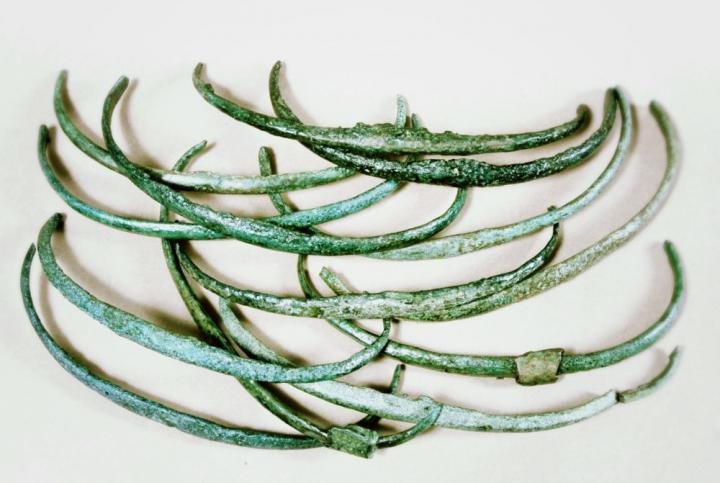Bronze ribs, pictured, as well as rings, axe blades and other objects, suggest people in Central Europe were using standardized currency at the end of the Early Bronze Age. Photo by M.H.G. Kuijpers
Jan. 20 (UPI) -- New research suggests groups of farmers living in Central Europe were exchanging standardized money -- in the form of bronze rings and ribs -- during the early Bronze Age, nearly 4,000 years ago.
According to the latest archaeological analysis, described Wednesday in the journal PLOS One, the use of standardized money in Central Europe may have developed independently from money systems that emerged in the Far East and Mediterranean.
Throughout the 20th century, hoards of rings, ribs and axe blades made of bronze have been recovered from early Bronze Age archaeological sites in Europe.
Most have been found in Germany, the Czech Republic, Austria, Switzerland and Poland, but also in France in Denmark.
Researchers have previously surmised that these bronze objects, of similar size, shape and weight, constituted a primitive money supply.
However, proving as much has proven difficult.
"It's an idea that has been around for some time. There's a paper by a German professor, Majolie Lenerz-de Wilde, from the nineties who had a first go at trying to show this using histograms," study author Maikel Kuijpers told UPI in an email.
"The problem is that such a method does not work very well. So, it remained a plausible but poorly evidence suggestion," said Kuijpers, an assistant professor of European prehistory at Leiden University in the Netherlands.
Instead of relying on histograms -- the visualization of numerical data -- Kuijpers and Leiden colleague Catalin Popa used a psychology principle called the Weber fraction to analyze more than 5,000 bronze objects.
"We went back to this data, added a lot more and -- importantly -- developed a novel method to calculate standardization from the perspective that people in the past were not weighing with the use of scales, but with their hands," Kuijpers said.
The Weber fraction describes differences in weight that are imperceptible to human hands - when two objects are similar enough in weight, they feel the same in a person's hands.
Researchers determined 70 percent of the bronze rings were within the Weber fraction. Smaller but significant portions of the ribs and axes also fell within the Weber fraction.
According to Kuijpers and Popa, their analysis confirms the bronze objects as convertible money, used to facilitate fair exchanges between local economies and agricultural societies.
"We see different zones in which different economies operated. These convertibles could vault the differences," Kuijpers said. "How exactly they were used is difficult to reconstruct. They may [have been] remelted and cast into different objects."
Though the latest findings highlight the emergence of monetary exchange during the early Bronze Age, Kuijpers suggests the more important revelation might be the emergence of standardization as both a material and cognitive principle.
"Metal can be casted in molds, it is easy to make copies. Hence, it affords standardization in a way," Kuijpers said. "This, we suggest, are the material dimensions of cognition. Such a view aligns with recent notions in cognitive science that cognition is a dynamic system, including mind, body and material."
"I would love to explore this in more detail, and also for different materials -- [it shows] the evolution of knowledge," Kuijpers said.















